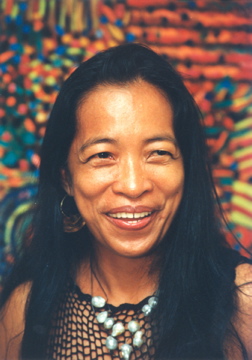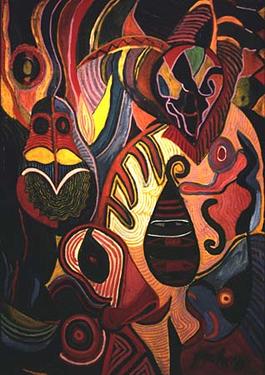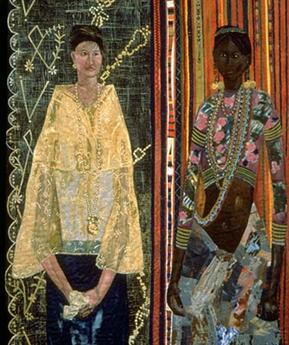Pacita Abad facts for kids
Quick facts for kids
Pacita Abad
|
|
|---|---|

Abad in 1990
|
|
| Born |
Pacita Abad
October 5, 1946 Basco, Batanes, Philippines
|
| Died | December 7, 2004 (aged 58) |
| Education | Corcoran School of Art Art Students League of New York |
| Alma mater | University of the Philippines Diliman (BA, 1967) Lone Mountain College / University of San Francisco (MA, 1972) |
| Known for | Painting, Trapunto painting |
Pacita Abad (October 5, 1946 – December 7, 2004) was a famous artist from the Philippines. She was born on a small island called Basco, Batanes, located in the northern part of the country. Pacita's painting career lasted over 30 years.
She started her journey as an artist when she traveled to the United States. Pacita showed her artwork in more than 200 places around the world. This included 75 special shows just for her art. Today, her paintings are found in art collections in over 70 countries.
Contents
Pacita's Early Life and School
Pacita Abad was born on October 5, 1946, in Basco, Batanes. Her parents were Jorge and Aurora Abad. She was the fourth of twelve children. Her father was a Congressman for Batanes. He later became a government minister. Her mother, Aurora, also became a Governor of Batanes.
After finishing elementary school in Batanes, Pacita went to high school in Manila. In 1968, she earned a degree in political science from the University of the Philippines Diliman. While studying law, Pacita's family faced political challenges.
It became unsafe for her to stay in the Philippines. So, her parents sent her to Spain to continue her studies. Before going to Spain, Pacita visited relatives in San Francisco. She decided to study in the United States instead. In 1971, she earned a master's degree in Asian History.
Pacita began her art training in 1975 at the Corcoran School of Art in Washington, D.C.. She also studied at the Art Students League of New York in New York City in 1978.
Pacita's Travels and Family
Pacita Abad lived on six different continents. She worked in more than 50 countries. Some of these countries include Guatemala, Mexico, India, and Indonesia. Her travels greatly influenced her art.
While in San Francisco, Pacita married George Kleiman, who was also a painter. They later separated. She then traveled across Asia for a year. Later, she married Jack Garrity. He became an expert in international development.
Pacita's Amazing Artworks
Pacita Abad created over 5,000 artworks during her life. Her early paintings often showed people and traditional masks. Another series of her works featured large paintings of underwater scenes, tropical flowers, and animals.
However, Pacita is most known for her bright and colorful abstract art. Many of these were very large paintings. She used different materials like canvas, paper, bark cloth, metal, and glass. She even painted the 55-meter long Alkaff Bridge in Singapore. She covered it with 2,350 colorful circles. She did this just a few months before she passed away.
Pacita developed a special art technique called trapunto painting. This name comes from a quilting method. She would stitch and stuff her painted canvases. This made them look three-dimensional and sculptural. She also added materials like traditional cloth, mirrors, beads, shells, and plastic buttons to her paintings.
In 2021, an exhibition of her work was shown in Dubai. It was called I Thought the Streets Were Paved With Gold. The show included many of her works. These ranged from abstract forms to realistic scenes of daily life. Her art was inspired by her experiences living in the United States and the Philippines.
Awards and Special Recognition
Pacita Abad received many awards for her art. Her most special award was the TOYM Award for Art in the Philippines in 1984. TOYM stands for The Ten Outstanding Young Men. Before 1984, only men had received this award. Pacita was the first woman to win it.
Some people were upset that a woman received the award. But Pacita was very happy that she had broken this barrier. In her acceptance speech, she said that "it was long overdue that Filipina women were recognized." She was proud to mention her mother as an example of an outstanding woman.
Here are some of her other awards:
- "Pamana Ng Pilipino Award" for outstanding art, given by the President of the Philippines, June 2000.
- "Plaque of Recognition" from the Province of Batanes, 2000.
- "Filipina Firsts", recognizing 100 Filipino women who achieved great things, June 1998.
- "Likha Award" for outstanding achievement, June 1998.
- "Excellence 2000 Awards for the Arts", May 1995.
- "Gwendolyn Caffritz Award", June 1992.
- "Mid-Atlantic Arts Regional Fellowship", June 1992.
- "National Endowment for the Arts", Visual Arts Fellowship, 1989 to 1990.
Pacita's Legacy
Pacita Abad created a unique trapunto painting technique. She has inspired many other artists. She received many international awards for her paintings. Her artworks are now in museums in Tokyo, Paris, London, Singapore, and New York City. Her art is part of national collections in at least 70 countries.
Her brother, Butch Abad, lovingly restored her studio in Batanes. It is now called the Fundacion Pacita Batanes Nature Lodge. Pacita Abad's works are often displayed in galleries and museums in the Philippines. This happens during the annual Philippine Arts Month and other art festivals.
On July 31, 2020, Google honored Pacita Abad with a special Google Doodle. This doodle celebrated her art style and the anniversary of her TOYM award.
Pacita's Inspiring Quote
Pacita Abad once said: "I always see the world through colour, although my vision, perspective and paintings are constantly influenced by new ideas and changing environments. I feel like I am an ambassador of colours, always projecting a positive mood that helps make the world smile."
See also
- Shaped canvas
- Filipino women artists



